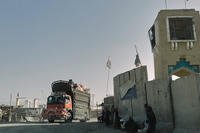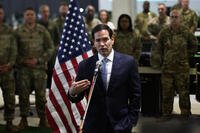The U.S. Army just completed a large-scale simulation that revealed the service must find ways to train and equip combat leaders to stay ahead of the enemy if units are to survive the new, fast-paced age of warfare on the horizon.
From Aug. 5-23, officials from the Maneuver Battle Lab at Fort Benning, Georgia, oversaw Unified Challenge 19.2, a joint, combined-arms simulation designed to assess the Army's ability to fight a near-peer adversary across all battlefield domains -- air, sea, land, space and cyber.
The experiment included more than 400 military role-players from Army Forces Command, U.S. Army Europe, U.S. Army Pacific, U.S. Army Special Operations Command, Space and Missile Defense Command and the U.S. Air Force.
Unlike standard tabletop exercises that rely on the experience of leaders, Unified Challenge was a "computer-based simulation down to the individual level that actually uses physical ... models using data that will respond in a real-world manner," Chris Willis, the Maneuver Battle Lab's Modeling and Simulations branch chief, told defense reporters Wednesday.
Related: Army May Redesign Its Fighting Formations in Look to the Future
The experiment included current combat platforms as well as future Army modernization priorities, such as variants of the Robotic Combat Vehicle and futuristic helicopters under the Future Vertical Lift effort.
"The combat vehicles that we use now and will use in the future are modeled in the simulation," Willis said. "You can actually get feedback on the logistics, number of rounds required, the amount of fuel required, the bandwidth required out of those models as opposed to professional military judgment, which is quite often used in those table-top experiments."
One of the key takeaways gleaned from the experiment is that leaders must be able to read the evolving operational environment so they can stay several steps ahead of the enemy, officials said.
To be successful at multi-domain operations, commanders must be able to use long-range precision fires, electromagnetic spectrum attacks or other "battlefield effects" to penetrate enemy defenses to open windows of opportunity, said Col. Mark Bailey, head of the Army Experimentation Division in Army Futures Command's Futures & Concepts Center, describing what's known as converging effects.
"Convergency [sic] is extremely difficult to do on a large scale, as we are seeing in these experiments," he said. "There is just too much going on, and it's happening too fast. Leaders must have a cognitive understanding of the operational environment. You need an effective common operating picture to do this."
Today's common operating picture is created through drone feeds and other intelligence, surveillance and reconnaissance assets being funneled into tactical operations centers.
"The problem is this common operation picture needs to be in your head rather than on a screen in front of you," Bailey said. "We need to be able to build some resilient systems that enable a commander or leader to be able to understand what's happening."
When a target window presents itself and "you don't have an artillery tube in range, you have to quickly say, 'What else do I have that can affect that target?' It doesn't have to be an artillery piece; it doesn't have to be an air platform. It can be an electromagnetic effect," he said.
"But you have to understand, if I fire that effect now, what's happening if I use that effect over here -- now I can't use it over here. Am I closing a window? I don't know because I really can't predict the future as well as I should be able to do it," Bailey said.
"We would look to things like artificial intelligence, additional assets -- maybe national technical means that can help us visualize things, but you've got to be in front, you've got to be playing chess not checkers, so you've got to be in front of a near-peer adversary by multiple steps. And to do that on the future battlefield is extremely difficult," he said.
Now that Unified Challenge is complete, officials will compile a report of the findings that is scheduled to be presented to the director of the Futures & Concepts Center by late November, Bailey said. Once approved, the findings will be made available to all branches of service.
The next step will be to use the data to conduct smaller experiments in 2020 to go after problems that were identified during this experiment.
Despite the challenges future leaders face, experiment officials said they were impressed at how quickly many of the participants learned how to cope in the challenging operating environment.
"The commanders and the staffs that we had were really impressive to me because they took these tools, these capabilities and they rapidly learned how to plan, coordinate, synchronize all the different tools that we provided them," said Col. Chris Cassibry, director of the Concepts Development Division in the Maneuver Capabilities Development and Integration Directorate at Benning.
They developed tactics, techniques and procedures for using these capabilities to "to facilitate maneuver and execute the mission," he added.
"It was a learning process. When you go to day one experiment and you go to day 13 of the experiment, the speed, the agility of which they moved and operated was very different," Cassibry said.
-- Matthew Cox can be reached at matthew.cox@military.com.
Read more: The Air Force Just Dropped 80,000 Pounds of Bombs on Island 'Infested' with ISIS Fighters












